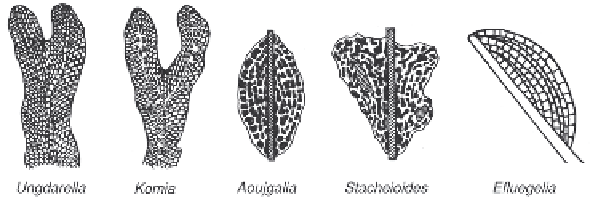Geology Reference
In-Depth Information
Mamet, B., Roux, A. (1977): Algues rouges dévoniennes et
carbonifères de la Téthys occidentale, part 4. - Revue de
Micropaléontologie,
19
, 215-266
Moussavian, E. (1989): Über die systematische Stellung und
Bestimmungskriterien der Solenoporaceen (Rhodophy-
ceae). - Courier Forschungsinst. Senckenberg,
109
, 51-91
Wright, V.P. (1985): Seasonal banding in the alga
Solenopora
jurassica
from the Middle Jurassic of Gloucestershire, Eng-
land. - Journal of Paleontology,
59
, 721-732
sic, and locally abundant in Jurassic and Cretaceous
patch reefs. Common genera are:
Solenopora, Para-
chaetetes, Cordilites
(Late Cretaceous)
, Elianella
.
Basics: Solenoporacean red algae
Johnson, J.H. (1960): Palaeozoic Solenoporaceae and related
red algae. - Quarterly, Colorado of School Mines,
55
, 1-
77
Plate 56 Late Paleozoic Ancestral Red Algae and Problematic Red Algae
The terms 'ancestral red algae' or 'ancestral coralline algae' refer to Late Paleozoic algae characterized by
differentiated blade-like thalli with hypo- and perithallus structures, thus reminding one of corallinacean algae.
Other taxa exhibit branched (-> 6) or irregular, encrusting forms (-> 4). Many taxa exhibit yellowish hyaline
structures pointing to a primary aragonite skeletal mineralogy that is also indicated by high strontium concentra-
tions in
Archaeolithophyllum
. Some genera (
Archaeolithophyllum
; -> 1, 2, 8) contribute to the formation of
mounds, others are common in open-marine shoals but also in restricted lagoonal carbonates.
Archaeolithophyllum
appears to be related closely to modern aragonitic Peyssoneliaceae. A few taxa, sometimes called 'pseudo-
algae', have been attributed to sponges, but are probably algae (
Ungdarella
, -> 7;
Fasciella
, -> 3, 4;
Komia
, ->
6). Some of these taxa are index fossils, particularly useful for biostratigraphic differentiation based on foramin-
iferal assemblage zones of Early Carboniferous shelf carbonates.
Fig. 10.9.
Late Paleozoic ungdarellacean al-
gae (
Ungdarella, Komia
) and stacheinacean
algae (
Aoujgalia, Efluegelia, Stacheoides
).
The interpretation of these mm-sized encrust-
ing microfossils is controversial, but many
workers assign them to red algae because of
the structural similarity with genuine
rhodophytes. After Chuvashov et al. (1987).
1
Archaeolithophyllum
Johnson. Ancestral coralline alga. Criteria: Crustose multifoliate sheets of differentiated cells. Promi-
nent hypothallus with large polygonal cells (arrows), poorly developed perithallus. Single high-arched conceptacles in the
perithallus tissue. Thalli often recrystallized, yellowish in transmitted light. Originally aragonitic skeleton. Top right:
Cross-section with distinct cell structure. Time range: Early Carboniferous to Early Permian, abundant in Middle and Late
Carboniferous. The genus is common in shallow-marine mounds and shoals. Late Pennsylvanian (Auernig Formation):
Gugga, Carnic Alps, Austria.
2
Archaeolithophyllum
Johnson. Note central hypothallus (HT) cells. The perithallus (arrow) is largely destroyed. Same
locality as ->1
3
Fasciella
Ivanova. Formerly named
Shartymophycus
. Regarded as red or green alga. Criteria: Encrusting nodular thallus,
composed of irregular concentric layers of elongated cells. Walls yellowish, hyaline. Time range: Carboniferous (Viséan
to Bashkirian). Common in open-marine shelf grainstones. Early Carboniferous (Viséan): Betic Cordillera, Spain.
4
Fasciella
Ivanova
.
Note nodular growth and irregular layers (arrow).
Middle Carboniferous: Nassfeld, Carnic Alps, Aus-
tria.
5
Efluegelia
Vachard
,
enclosed in an oncoid. Probably an ancestral red alga. Criteria: Encrusting thallus consisting of a few
thin rows of minute, subparallel laminae with quadratic cells. Walls yellowish, hyaline. Commonly enclosed in biogenic
crusts. Time range: Carboniferous and Early Permian. Early Permian (Asselian): Carnic Alps, Austria.
6
Komia
Korde. Criteria: Ramified robust thallus composed of rectangular and quadrangular cells. Walls yellowish, hya-
line. Time range: Middle Carboniferous to Early Permian. Common in shelf carbonates. Late Pennsylvanian (Gzhelian):
Hüttenkofel, Carnic Alps, Austria.
7
Ungdarella
Korde. Criteria: Ramified thallus, perithallus with long thin rows of subquadratic cells. Time range: Carbon-
iferous and Early Permian. Common in Middle Carboniferous shelf carbonates. Carboniferous (Viséan/Namurian): Rif
Mountains, northern Morocco.
8 Rhodoid with thin crusts of
Archaeolithophyllum lamellosum
Wray. The alga has coated phylloid algae (
Eugonophyllum
,
E; Pl. 58/3) as well as a rugose
Dibunophyllum
-type coral (C). Note the loose organization of the cm-sized oncoid and the
inclusion of mud chips (MC), indicating that coating was a nonselective process. Late Pennsylvanian (Leavenworth
limestone, Virgilian; transgressive part of a megacyclothem): Osage County, northern Oklahoma, U.S.A.
-> 8: Toomey 1983

